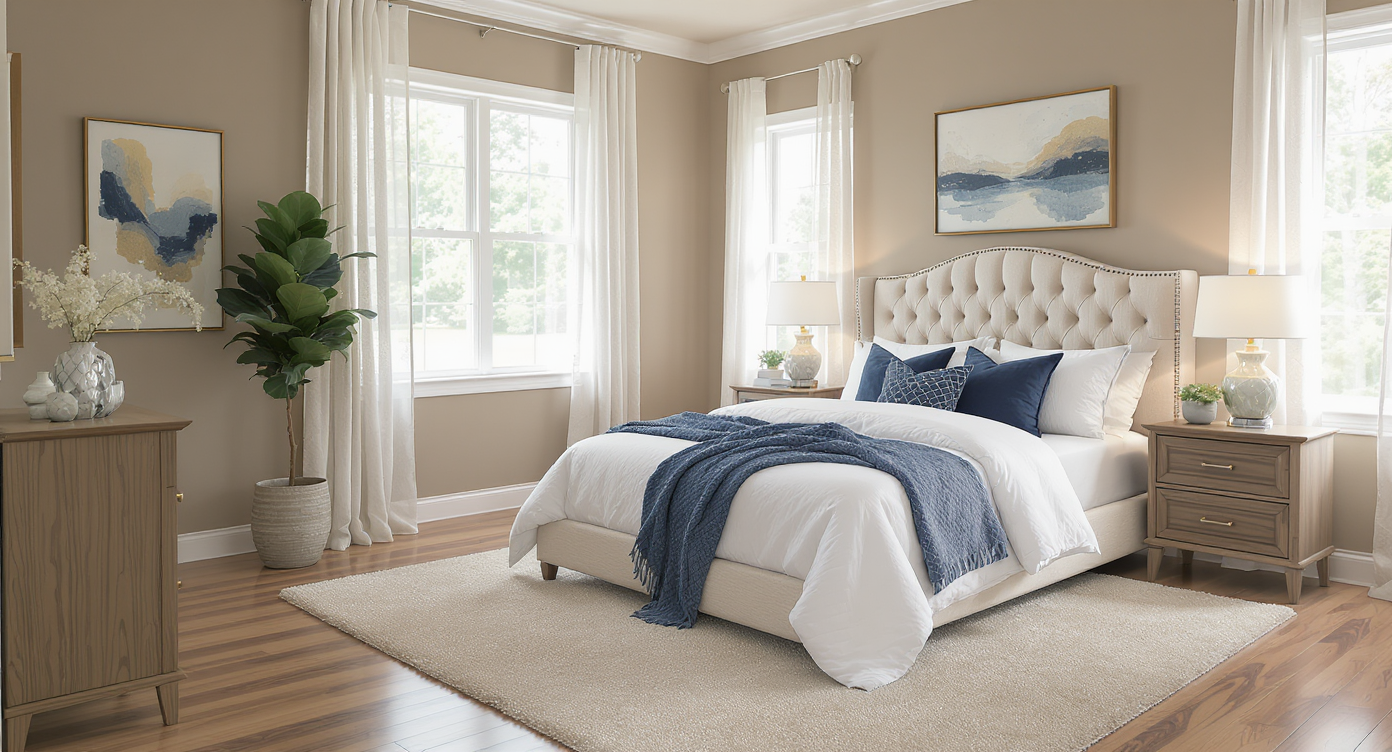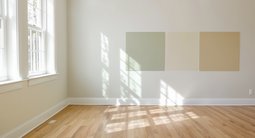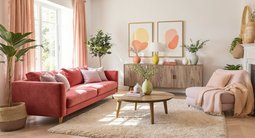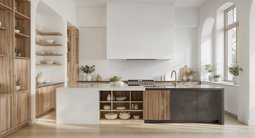TL;DR
Virtual staging aligned to buyer personas turns generic photos into targeted real estate marketing. Expect more saves, better showings, and offers that arrive faster — without the cost of full physical staging.
Virtual Staging Meets Buyer Personas

Virtual staging aligned with buyer personas creates relatable spaces that boost listing appeal.
Turn listing photos into buyer magnets by pairing virtual staging with buyer personas; improve clicks, showings, and offers without overspending.
Tailored Virtual Staging Wins Clicks: How Buyer Personas Turn Empty Rooms into Offers
When rooms mirror the life buyers imagine, listings stop being scrolled past and start getting scheduled showings.
Virtual staging is now a front-line listing strategy, and buyer personas make it precise. Nearly all home searches begin online, and agents widely report that homes with compelling, realistic listing visuals earn more clicks and more tours. Surveys often find that around 8 in 10 buyer’s agents say staging helps clients visualize a property, and many see offer estimates tick up 1–5% when presentation is on point. The takeaway: virtual staging plus buyer personas is a low-cost way to lift perceived value and reduce days on market.
Here’s the thing: buyers don’t want a generic catalog. They want a life they recognize. Persona-driven virtual staging aligns the furniture, color palette, and layout to the people most likely to buy — and it works.
National Data Insight
National Data Insight
Virtual staging and home staging both raise engagement, and experts say the difference shows up quickly in property photos and inquiries. Agents commonly cite listing cost ranges of $25–$75 per virtually staged image versus $2,000–$5,000 per month for traditional staging, with well-presented listings attracting more showings within the first 7–10 days. In agent surveys, roughly 80% say staging helps buyers picture themselves in a home, and a meaningful share report 1–5% higher perceived value when staging matches the property’s price point and style.
Rule of thumb: keep virtual staging realistic enough that buyers recognize the space at showings. Practitioners recommend accurate proportions, true window views, and a short disclosure — “some images virtually staged.”
Visualization note: show a before-and-after sequence so clients grasp both the room’s scale and its potential. Caption: Great room, empty vs. virtually staged; Alt text: large living space with sectional, neutral rug, and art highlighting the fireplace.
Anecdote
A Brooklyn condo seller targeted first-time buyers. After swapping heavy traditional pieces for a light oak desk, slim sofa, and a tucked-away bar cart, the listing pulled in three offers in five days. The buyer mentioned the staged WFH setup by name during the walkthrough.
Regional and Segment Playbook
Regional and Segment Playbook
Virtual staging shines when it’s tuned to local real estate marketing realities and buyer personas. Agents often advise tailoring style by metro, price tier, and lifestyle — it’s not one look fits all.
- Urban tech hubs (Seattle, Austin, Boston): Modern or Scandinavian virtual staging with light woods, clean lines, and a defined WFH nook. Expect younger buyers to value storage, acoustics, and natural light. Designers suggest cooler palettes and matte finishes.
- Sun Belt suburbs (Phoenix, Tampa, San Antonio): Transitional staging that blends comfort with clean silhouettes. Family-focused layouts with a play corner, drop zone, and indoor-outdoor flow routinely earn more saves.
- Luxury coasts (Miami, Orange County): Luxury staging with statement lighting, stone accents, and art-scaled walls. Market analysts suggest emphasizing spa-primary suites and entertaining islands; buyers in this tier expect layered textures and symmetry.
- Mountain and lake markets: Warm modern or soft rustic with natural textures and window-centered furniture plans. Keep views unobstructed and scale sofas to the span of the windows.
- 55+ downsizers: Comfort-forward transitional with wider pathways, fewer trip points, and easy-reading color contrast. Agents often recommend showing a flex room as hobby space rather than a third office.
Mini case: a Denver townhome aimed at remote workers swapped bulky sofas for a slim sectional and added a glass desk to a sunny corner. Showings doubled in a week, and the eventual buyer referenced “that home office vibe” during negotiations.
Behavioral Triggers and Market Psychology
Behavioral Triggers and Market Psychology
Virtual staging only converts when it resolves buyer friction in the decision journey. Homebuyers today expect rooms to demonstrate function — a primary suite that decompresses, a kitchen that hosts, a bedroom that flexes to nursery or office. When those stories are clear, buyers stop mentally redecorating and start imagining move-in dates.
Three recurring triggers agents observe:
- Scale anxiety: Empty rooms read smaller; adding correctly scaled furniture restores spatial confidence. One listing photo with a queen bed and 24-inch nightstands can settle the “will it fit?” debate instantly.
- Identity match: Persona-fit styling combats “this isn’t for me.” Contemporary art and a simple credenza speak to urban professionals; a reading nook and bench storage cue young families.
- Decision fatigue: Too many decor moves overwhelm; a cohesive theme and 3–4 materials reduce cognitive load. Market psychologists note buyers prefer fewer, stronger cues.
A veteran agent put it simply: “If they can see their mornings, they can see their offer.”
Secondary Trends, Guardrails, and A/B Lessons
Secondary Trends, Guardrails, and A/B Lessons
Virtual staging is most persuasive when marketing tests guide choices. Listing strategies that pair a naked room image immediately followed by a virtually staged version — with a clear disclaimer — tend to earn trust and longer dwell times.
- A/B the hero photo: Test a staged living room against the kitchen. In many markets, living rooms win the click, but data often flips for new construction where the kitchen island is the star.
- Show the flex: Re-stage one secondary bedroom as a home office or gym. Agents report 10–20% more saves when a legitimate WFH zone is obvious.
- Mind mobile: Crop for phones first; put the focal point within the top third. Tap-friendly carousels benefit from before/after sequencing.
- Stay honest: Keep finishes plausible, don’t add architectural elements, and retain true views. Experts recommend a one-line disclosure on every image to avoid showroom shock at the first tour.
- Cost discipline: Budget 6–12 images per listing. At $25–$75 per image, you can comprehensively cover living, dining, kitchen, primary suite, and one flex room for under a typical week of physical staging fees.
Mini case: a Phoenix flip initially launched with empty rooms and stalled at 21 days on market. The team added persona-led virtual staging — transitional style, patio dining, and a kid’s reading corner — and saw a 30% jump in inquiries the next week.
Counterpoint: in ultra-tight inventory pockets, some homes fly off the shelf without staging. Even there, agents caution that clean, decluttered photos and a single staged hero shot still set better expectations and reduce renegotiation risk.
Visualization Scenario
Alt text: primary bedroom staged with low-profile bed, soft neutral bedding, and black dome lamps; Caption: Minimalist primary with layered textures tailored to an urban buyer persona.
FAQs
FAQs
How should I tailor virtual staging to buyer personas for real estate marketing?
Match style, color, and room function to your ideal buyer persona — for example, modern/Scandinavian for urban professionals or transitional for young families — and disclose images as virtually staged.
What’s the best way to use virtual staging and home staging together?
Use virtual staging for listing photos to drive traffic, then keep the home decluttered and clean for tours; many agents show a naked room image followed by a virtually staged version for transparency.
How much does virtual staging cost vs. traditional home staging?
Virtual staging often runs $25–$75 per image, while physical staging can cost $2,000–$5,000 per month; most sellers stage 6–12 photos to cover key spaces and a flex room.
Does virtual staging help sell a house faster in competitive markets?
Agents report that persona-aligned virtual staging increases clicks, showings, and offer quality, with many seeing faster movement in the first 7–10 days when photos are realistic and consistent.
What are the rules for virtual staging disclosure and realism?
Always label images as virtually staged, avoid adding non-existent architectural features, keep proportions and views accurate, and consider a side-by-side before/after to set expectations.
Market Outlook and Reflection
Market Outlook and Reflection
Virtual staging is evolving fast, and smart real estate marketing is getting personal. Expect AI to accelerate persona-matched palettes, layout suggestions, and accessory sets that stay realistic to each floor plan. The north star won’t change: believable rooms that reflect a specific buyer’s life beat generic beauty shots every time.
Deals rarely falter because a sofa was beige; they falter when buyers can’t picture their life. Tools that translate rooms into routines will keep winning. If you want a fast way to visualize multiple looks, explore ReimagineHome to prototype modern, transitional, or luxury staging that fits your exact buyer persona before you hit publish.
Tags: virtual staging, home staging, real estate marketing, buyer personas, property photos, listing strategies, virtual tours, staging ROI
.svg)

.svg)









.png)